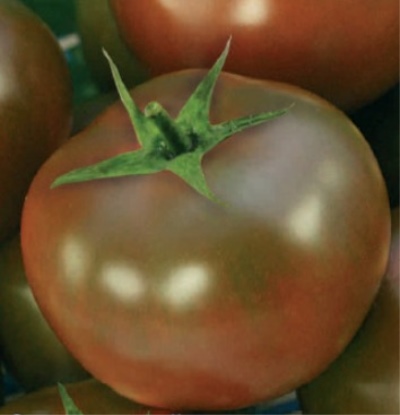
- Authors: Marina Danilenko, Russia
- Category: grade
- Growth type: semi-determinant
- Appointment: fresh consumption
- Ripening period: mid-season
- Ripening time, days: 105-110
- Growing conditions: for open ground, for film greenhouses
- Transportability: Yes
- Bush size: tall
- Bush height, cm: 120-150
The standard color of tomatoes is bright red or pink. However, there are other options as well. The unusual color of the fruits does not go unnoticed by both experienced gardeners and amateur gardeners who want to get a tasty and high-quality harvest. Tomato Paul Robson stands out from the rest precisely due to the unusual skin color.
Description of the variety
In open or closed ground conditions, the vegetable crop will feel great and will please with stable fruiting. Growth type is semi-determinate. Bushes are considered tall. Their height varies from 120 to 150 centimeters. They are compact and moderately spreading plants with medium foliage. Ripe tomatoes are eaten fresh or used as an ingredient in a salad. Up to 5 ovaries are formed in one bone, which then become tomatoes. Leaves are medium in size, dark green.
The main qualities of the fruit
The color of ripe tomatoes is red-brown, uneven. In one place, a scarlet hue will be more noticeable, in another - dark or light brown. The shape is rounded and slightly flattened. There is a slight ribbing at the place where the peduncle is attached to the fruit. The flesh is of a watermelon type, fleshy. Inside, many seed chambers are formed, but with a small number of seeds. Fruits are covered with strong and thin skin. It will protect the crop from deformation and cracking. Weight - from 150 to 250 grams on average. The fruits are not watery.
Vegetables are recommended for baby or diet food due to their rich content of lycopene and sugars.
In addition to being consumed in their natural form, tomatoes are used for:
pastes;
juice;
refueling;
ketchup;
canning;
stuffing;
extinguishing.
Taste characteristics
The taste is pronounced with a fruity aftertaste. Sweet notes are noticeably dominant.
Ripening and fruiting
The Paul Robson variety belongs to the mid-season varieties, and the fruit ripening period is from 105 to 110 days.
Yield
The yield is excellent. From 8 to 12 kilograms of juicy fruits are harvested from a square meter of the garden. The amount of vegetables depends on the growing conditions and the care of the bushes.
The timing of planting seedlings and planting in the ground
From the second half of March, you can start sowing seeds for seedlings. After May 20, young plants can be transplanted into soil for further cultivation. The approximate age of the seedlings should be 60 days. To make the seeds germinate faster, they are treated with Kornevin and Zircon preparations. You can find them at any gardening store.
For the germination of tomatoes, it is important to choose the right soil. It should be light, nutritious and loose. It is best to buy a ready-made mixture that will already be pre-processed. If it is not possible to purchase a soil mixture, it can be prepared on the basis of garden turf.
The following components are added to it:
peat;
sand;
ash;
compost.
To disinfect the earth, it is treated with a solution of potassium permanganate or "Fitosporin" 1%.
A number of recommendations for the care of seedlings:
illuminate containers with seed with phytolamps with a lack of natural light;
dive seedlings into separate containers with a volume of 0.5 liters;
plants are hardened at a temperature of +14 degrees Celsius;
fertilize tomatoes with minerals and organics 2-3 times.
In a late blight epidemic, plants need additional processing. They are sprayed with copper preparations and fungicides.

Growing tomato seedlings is an extremely important process, because it largely depends on whether the gardener will be able to harvest at all. All aspects must be taken into account, from seedbed preparation to planting in the ground.
Landing scheme
The permissible planting density is up to 3 bushes per square meter.

Growing and care
After transferring the seedlings to a permanent growing site, you need to perform a number of activities. Do not allow the soil to dry out. Water the tomatoes sparingly, using only warm water. Cold liquid is bad for plants and inhibits their growth. And also such watering provokes the discharge of ovaries. The lower leaves are torn off every 5-7 days to improve the air exchange process.
The formation of bushes strongly affects the yield. Tomatoes form into 2 stems. All remaining extra stepsons, which are formed above the 5th fruit brush, are removed. To make the tomatoes as large as possible, no more than 3-4 ovaries are left in one brush.
Top dressing is needed for juiciness and high taste characteristics. During the season, tomatoes are fertilized 2-3 times. For each period, choose their own compositions. During flowering, mineral compounds are used that are rich in calcium, potassium, phosphorus and iron. During the formation of vegetables, bushes need magnesium sulfate and a full range of trace elements. It is not recommended to use nitrogen-containing top dressing in the second half of the growing season, since this component provokes the formation of green mass.
Tall plants need to be grown with strong supports. They will help keep the branches and crops intact. Tie up the shoots carefully so as not to damage them.




A plant needs different micronutrients at each stage of growth. All fertilizers can be divided into two groups: mineral and organic. Folk remedies are often used: iodine, yeast, bird droppings, eggshells.
It is important to observe the rate and period of feeding. This also applies to folk remedies and organic fertilizers.



























































































